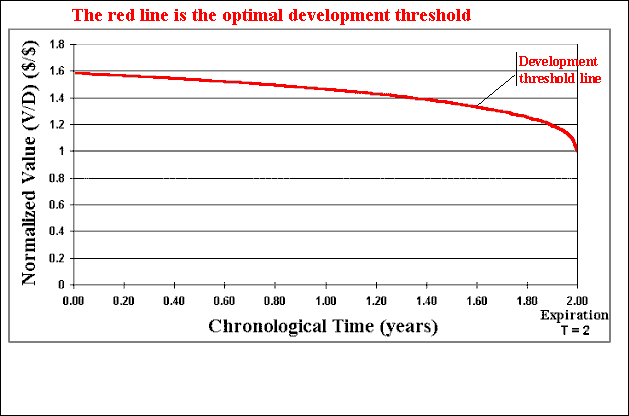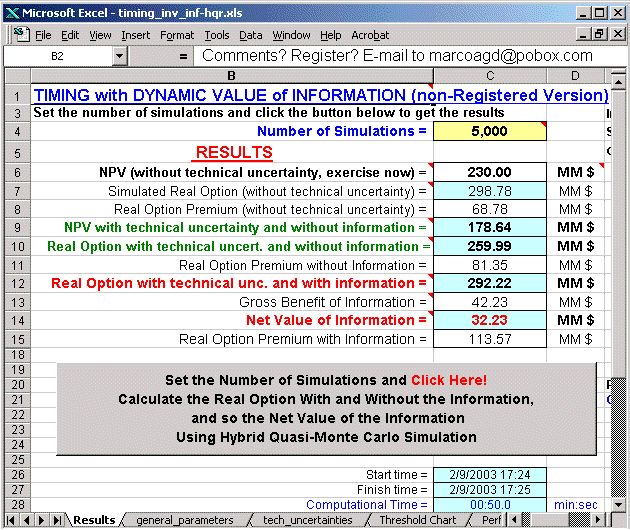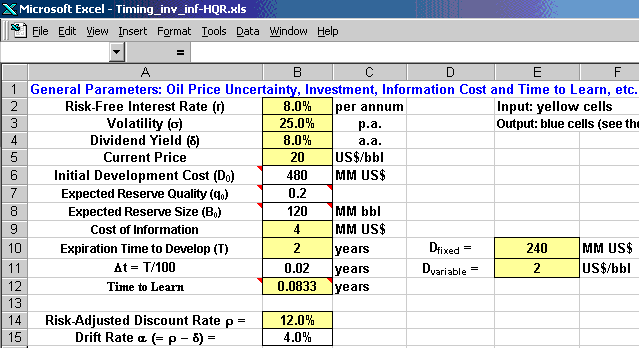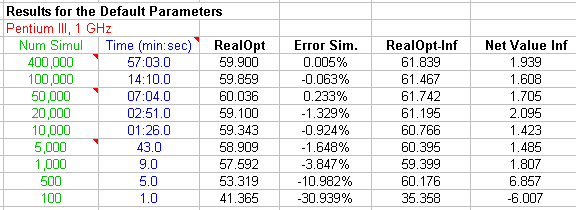This page presents the main features of the real options software Timing
with Dynamic Value of Information.
There are many resource to explain a simple way to combine technical
uncertainties revealed by the investment in information with a stochastic
process (geometric Brownian motion) representing the market uncertainty on
the oil prices (or uncertainty on the equilibrium level for the oil
prices).
This software permits to consider not only the cost and the benefit of
the information, as the effect of the time to learn.
So, you can analyze and compare several alternatives to invest in
information, considering the different cost of information, different
benefit of the information generated (captured by the revelation distribution),
and different time to gather and transform data into information and
knowledge (time to learn).
For more details on the distribution of new expected values generated by
the new information, see the page on technical
uncertainty and the information revelation concept.
Download the paper Investment in Information in Petroleum, Real Options and Revelation, which presents the main issues for this analysis, including the 4 propositions to characterize the technical uncertainty and the learning process through the concept of revelation distribution.
Consider an oilfield development project, which has some (perhaps important) remaining technical uncertainties on the reserve size and the reserve quality. There are two main questions for investment decision:
The development investment magnitude in general is much higher than the
investment in information one, so that additional information can prevent
wrong investments and/or the underinvestment in a valuable oilfield.
Hence, the investment in information permits an additional optimization of
the development investment and is necessary a good way to quantify the
economic value of an investment in information. You can also compare
different alternatives of investment in information, by changing its
information cost, revelation distributions and time to learn features.
Timing with Dynamic Value of Information is a practical quantitative tool to perform these very important jobs.
The main issues in this page are:
![]() The
Value of Information into a Dynamic Framework (with animation)
The
Value of Information into a Dynamic Framework (with animation)
![]() Inputs, Outputs, Software Screens and the Registered Version
Inputs, Outputs, Software Screens and the Registered Version
![]() Download
Timing with Dynamic Value of Information (nonregistered
version of the software).
Download
Timing with Dynamic Value of Information (nonregistered
version of the software).
![]()
One assumption for investment in information analysis is to consider as
a necessary condition that the information has value if it leads to a
fairer knowledge. So, here are considered only investments in information
that increase the knowledge in a fairly way.
However, it is not enough. The information can reveal few additional
insights (so the value of this information is not high). Other
alternatives of investment in information can be costlier but can reveal
much more new relevant information about the parameter with technical
uncertainty object of analysis.
The value of information is an increasing function of the reduction
of uncertainty caused by the information revelation.
Consider the concept of revelation distribution for a
parameter value inferred after the information revelation. This
distribution is just the probability mapping of the possible values for
this parameter, after the information revelation.
In general, the information revelation changes both the project value (V)
and its development cost (D).
For a simple step-by-step example and to
understand better the revelation distribution, click here.
The information is costly. When facing a investment decision under
technical uncertainties, in general there are several ways to reduce these
uncertainties. Some alternatives of investment in information
are more expensive but has higher revelation power about
the true parameter value, investigating several aspects from the reality.
A good alternative of investment in information searches the maximum
reduction of uncertainty (higher revelation power) at a lower cost as
possible.
The best alternative of investment in information needs to be more
valuable than the alternative zero, that is, the alternative of not
investing in information. The difference between the real options with
the additional information and the real options without
information (alternative 0) is the net value of
information. In this software, this value is one of the main output.
The real option without information is calculated with both methods, the
Monte Carlo method and an analytical approximation due to Bjerksund &
Stensland (1993).
Consider a non-sequential investments in information (one-shot
investment in information, from a set of mutually exclusive alternatives).
The benefit of the investment in information is related to the dispersion
(variance) of the revelation distribution.
The idea in a synthetic example: consider an undeveloped oilfield with
remaining technical uncertainties on the reserve volume and on the reserve
quality (productivity). Drilling a low-cost slim well or drilling a
more-expensive horizontal well are investment alternatives with very
different revelation power and information cost, what is
the better cost/benefit balance?
There is also the interaction of market uncertainty (the
oil price) with the technical uncertainties, how to consider?
The market uncertainty needs a stochastic process model and estimation of
the stochastic process parameters.
For the real options with time to expiration, as in petroleum industry, this is another important dynamic issue. It is necessary to consider the time until the real option expiration (in case of a petroleum concession, there is a time to present a development investment compromise).
How to consider together in the same model the information cost, the information benefit (the revelation distribution), the time to learn, the time to expiration, and the market uncertainty? This is all that the software Timing with Dynamic Value of Information performs with focus on a practical problem of an oilfield development, which is possible to make an additional investment in information and/or to invest in the oilfield development. There is a time to expiration for the rights to develop the oilfield (at the expiration or the oil company assumes a development investment compromise, or the concession rights returns back to the Petroleum Agency).
The investment in information has another aspect: the time that the investment in information takes to gather the data and to process the information in order to transform it into knowledge about the key parameters of our project. This time is here called time to learn.
The animation below illustrates the calculus methodology of the software Timing with Dynamic Value of Information, in this chart of the normalized value of project V with development cost D, with an expiration time of two years:

The animation above shows that the evaluation process takes the following steps:
The Monte Carlo simulation is performed using a VBA (Visual Basic for Applications) software build in an Excel spreadsheet, which uses the more efficient Hybrid Quasi-Monte Carlo Approach (see the pages on Quasi-Monte Carlo Simulation for more details).
The main basic equations used in the software Timing with Dynamic Value of Information for the cases of development option exercise are:
NPV = Net Present Value = V - D
Value of Producing Project (or value of the developed reserve) = V = q P B - D.
Where q = economic quality of the
reserve; P is the oil price (US$ /bbl); and B = reserve volume size.
OBS: The above equation is from the so called "Business Model". See an in depth discussion on this and others alternatives for the NPV equation in the webpage on payoff models.
D = Development Cost = Fixed Cost + Variable (with B) Cost = Dfixed + Dvariable B
The above equation adjust the investment in capacity to the the reserve volume B. With the new information about the true value of B we can optimize the project using the adequate investment given by the above equation. With technical uncertainty about B, we can overinvest or underinvest in capacity losing money in both cases when compared with the case of perfect information (without technical uncertainty on B).
The variables with technical uncertainties are the reserve
quality and the reserve size B. These two variables captures the key
technical parameters in terms of economic relevance for the discounted
cash-flow analysis, the quantity and the velocity that the reserve is sold
in the market, that is, the present value of the net revenues.
The variable with market uncertainty is the oil price P, which follows a
geometric Brownian motion. See why geometric Brownian motion for oil
prices is not bad for real options applications (as many people think) in my
online overview paper or in the Pindyck's
paper in the Energy Journal, 1999.
Timing with Dynamic Value of Information is an Excel applicative with VBA program that solves the problem of a real option with opportunities to invest in information, using the approach summarized here, and better described in the technical uncertainty webpage and in the paper Investment in Information in Petroleum: Real Options and Revelation.
In order to solve this problem, the software consider the following inputs:
The outputs from the program are:
The following pictures show the non-registered version of the software Timing with Dynamic Value of Information. The screens permit to describe some additional features of this software or to understand how to work in practice with the concepts presented before.
The picture below illustrates the sheet of results and also the screen to set the number of simulations (number of sample paths) and the button to start the Monte Carlo evaluation of the real options with information, the real options without information and the difference, the net value of information. The program calculates also the computational time for each simulation running. In the example below, the NPV of development is zero, but the real options value (even without information) is valuable.

The screen below is the main data input sheet. The parameters for the geometric Brownian motion for the oil prices, the expiration time, the parameter for the development cost equation, the cost of investment in information, the time to reveal the information (time to learn).

There are many inside comments into several cells, which provides a fast help for the user in a practical way. Look in the picture above the small red bullet at the upper-right corner of some cells, indicating the existence of comments.
The figure below presents another sheet from the Excel file with this
software. This is the screen to enter the technical parameters for the
revelation distribution caused by the investment in information being
considered. In the non-registered case, only the triangular distribution
is available. For the registered version, there are many distributions to
choose for technical parameters: Triangular, Normal, Truncated Normal,
LogNormal, and Uniform.
The hybrid Quasi-Monte Carlo Simulation uses
randomized Halton sequences (bases 3 and 5 for these technical
uncertainties, and base 2 for the oil prices uncertainty).

In order to get an idea about the computational time, I set a screen with a table of many simulations that I performed using my personal computer Pentium III with 1 GHz of clock speed. Before setting the number of simulations, look this table in order to have an idea about the computational time (and compare your running time reported in the "results" sheet with the table below.

The critical threshold for the optimal development option exercise and the analytical approximation used for the real option value without information, are based in the closed-form equations from Bjerksund & Stensland ("Closed-Form Approximation of American Options", Scandinavian Journal of Management, vol.9, 1993, pp.87-99). According the Haug's textbook, this approximation is more accurate than the more popular Barone-Adesi & Whaley for long term options. This is exactly the general case of real options.
In this non-registered version, some input parameters are fixed. The fixed parameters are:
Off course in the registered version all these input parameters above are permitted to change. In addition, the technical uncertainties for both economic quality of the reserve q and the reserve volume B is not limited to the Triangular Distribution as the non-registered version. There are several distributions to choose.
The link below permits the download of the non-registered version of Timing with Dynamic Value of Information, an Excel spreadsheet with facilities provided by the VBA code including a very efficient Hybrid Quasi-Monte Carlo simulator.
![]() Download
the non-registered version of Timing with Dynamic Value of Information:
Compressed (.zip) Excel File timing_inv_inf-hqr.zip
with 732 KB .
Download
the non-registered version of Timing with Dynamic Value of Information:
Compressed (.zip) Excel File timing_inv_inf-hqr.zip
with 732 KB .
![]() Alternative
download: Non-compressed Excel File timing_inv_inf-hqr.xls
with 796 KB .
Alternative
download: Non-compressed Excel File timing_inv_inf-hqr.xls
with 796 KB .
The non-registered version is limited only by the type of probability distribution for the technical parameters (only Triangular distribution) and some few parameters are fixed (initial oil price, interest rate, dividend yield, time to expiration, and variable parameter for the development cost).
The registered version is full functional and, instead only
triangular distribution for technical uncertainties, the user has 5
different distributions to choose: Triangular, Normal, Truncated Normal,
LogNormal, and Uniform.
Others distributions can be added by consult (send me an e-mail).
The registered user gain the full functional version of this software
and, if he/she wishes, also another version of this software using
the @Risk functions (instead my VBA macro, which is
faster) for the Monte Carlo simulations. With these two versions, the user
can compare the results (and the computational time) of the @Risk with my
version using the VBA hybrid quasi-Monte Carlo simulator.
Users of Crystal Ball that wish a registered version of
Timing with Dynamic Value of Information using Crystal Ball
functions, please consult me before by sending an email to
marcoagd@pobox.com.
The registration fee is US$ 40, using the Gift Certificate to
buy books in Amazon.com or Amazon.co.uk.
See the page about how to register software and
licence fees.